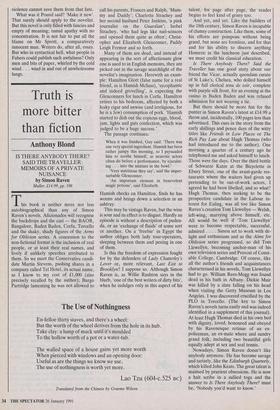Truth is more bitter than fiction
Anthony Blond
IS THERE ANYBODY THERE? SAID THE TRAVELLER: MEMOIRS OF A PRIVATE NUISANCE by Simon Raven Muller, £14.99, pp. 198 This book is neither more nor less autobiographical than any of Simon Raven's novels. Aficionados will recognise the backdrops and the cast — the BAOR, Bangalore, Baden Baden, Corfu, Torcello and the shaky, shady figures of the Arms for Oblivion series. A concession to the non-fictional format is the inclusion of real people, or at least their real names, and lively if unlikely speeches attributed to them. So we meet the Conservative candi- date Martin Stevens, pushing shares in a company called Tel Hotel, its actual name, as I know to my cost of £1,000 (also precisely recalled by the author); Burgo Partridge lamenting he was not allowed to call his parents, Frances and Ralph, 'Mum- my and Daddy'; Charlotte Strachey and her second husband Peter Jenkins, 'a pink journalist on the Guardian'; Isobel Strachey, 'who had legs like nail-scissors and opened them quite as often'; Christ- opher and Elizabeth Glenconner, Paddy Leigh Fermor and so forth.
Many of them are dead, and instead of appearing in the sort of affectionate glow one is used to in English memoirs, they are picked out in the savage searchlight of the novelist's imagination. Herewith an exam- ple: Hamilton Glott (false name for a real friend, as is Hamish McSass), 'sycophantic and indeed grovelling', is expecting the Glenconners for lunch in Corfu. Hamilton retires to his bedroom, affected by both a leaky cigar and unwise (and irreligious, for he is a Jew) consumption of pork. `Hamish started to dish out the copious eggs, blood, jam, lights and guts confection, which was judged to be a huge success.'
The passage continues:
When it was finished, Guy said: 'There was one very special ingredient. Hamish has been rather jumpy this morning, so I peisuaded him to soothe himself, as neurotic actors often do before a performance, by ejaculat- ing . . . into the mixture in the bowl.'
`Very nutritious they say', said the imper- turbable Glenconner.
`An important element in benevolent magic potions', said Elizabeth.
Hamish checks on Hamilton, finds he has worms and brings down a selection in an ashtray.
This may be vintage Raven, but the wine is sour and its effect is to disgust. Hardly an episode is without a description of puden- da, or an 'exchange of fluids' of some sort or another. On a 'freebie' in Egypt the author obliges both lady tour-operators, sleeping between them and peeing in one of them.
Is this the freedom of expression fought for by the defenders of Lady Chatterley's Lover or, more relevant, Last Exit to Brooklyn? I suppose so. Although Simon Raven is, as Willie Rushton says in the blurb, 'one of the best writers of dirty bits', when he indulges only in this aspect of his talent, for page after page, the reader begins to feel kind of grimy too.
And yet, and yet. Like the builders of the 18th century, Simon Raven is incapable of clumsy construction. Like them, some of his efforts are pompous without being grand, but none are formless, and for that and for his ability to discern anything Homeric in the luncheon just described, we must credit his classical education.
Is There Anybody There? Said the Traveller has one good story about our friend the Vicar, actually quondam curate of St Luke's, Chelsea, who dolled himself up in full clerical tenu de soir, complete with purple silk front, for an evening at the casino in Baden Baden and was refused admission for not wearing a tie.
But there should be more fun for the punter in Simon Raven's latest at £14.99 a throw and, incidentally, 100 pages less than advertised. This cues in the story from the early shillings and pence days of the witty titles like Friends in Low Places or The Rich Pay Late about Hugh Thomas (who had introduced me to the author). One morning a quarter of a century ago he telephoned me and asked himself to lunch. Those were the days. Over the third bottle of Schwarze Katze at the Bicyclette in Ebury Street, one of the avant-garde res- taurants where the waiters had given up pretending to be out-of-work actors, I agreed he had been libelled, and so what? Hugh Thomas, then seeking to be the prospective candidate in the Labour in- terest for Ealing, was all too like Simon Raven's creation Tom Llewellyn — Welsh, left-wing, marrying above himself, etc. All would be well if 'Tom Llewellyn' were to become respectable, successful, admired . . . . Simon set to work with de- light and enthusiasm and as the Alms for Oblivion series progressed, so did Tom Llewellyn, becoming anchor-man of his own television series and Provost of Const- able College, Cambridge. Of course, like all the author's friends and acquaintances characterised in his novels, Tom Llewellyn had to go. William Rees-Mogg was found dead in his bath in Albany. Dickie Muir was killed by a slate falling on his head when visiting the Getty Museum in Los Angeles. I was discovered crucified by the PLO in Torcello. (The key to Simon Raven's novels turns easily and was indeed identified in a supplement of this journal). At least Hugh Thomas died in his own bed with dignity, loved, honoured and obeyed by his Ravenesque retinue of an ex- policeman, an ex-male whore and sundry grand folk, including two beautiful girls equally adept at sex and real tennis.
Nowadays, Simon Raven doesn't like anybody anymore. He has become savage and tartarly, like the Edinburgh Quarterly, which killed John Keats. The great talent is maimed by prurient obsessions. He is now a halt scribe in a sullied toga and the answer to Is There Anybody There? must be, 'Nobody you'd want to know.'


























































 Previous page
Previous page